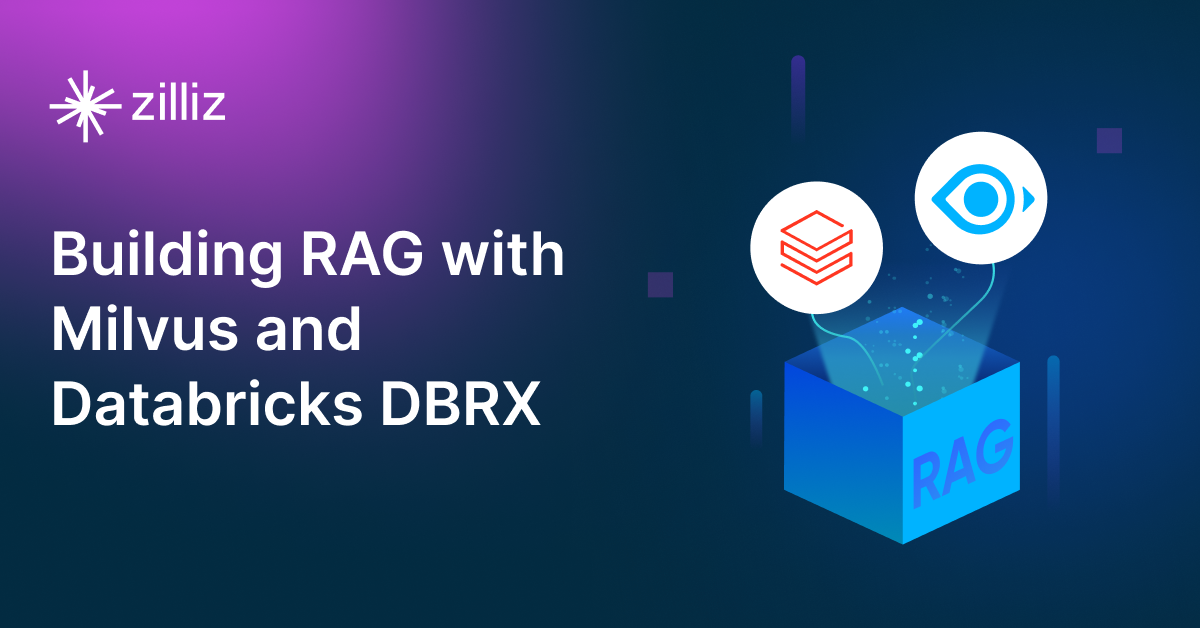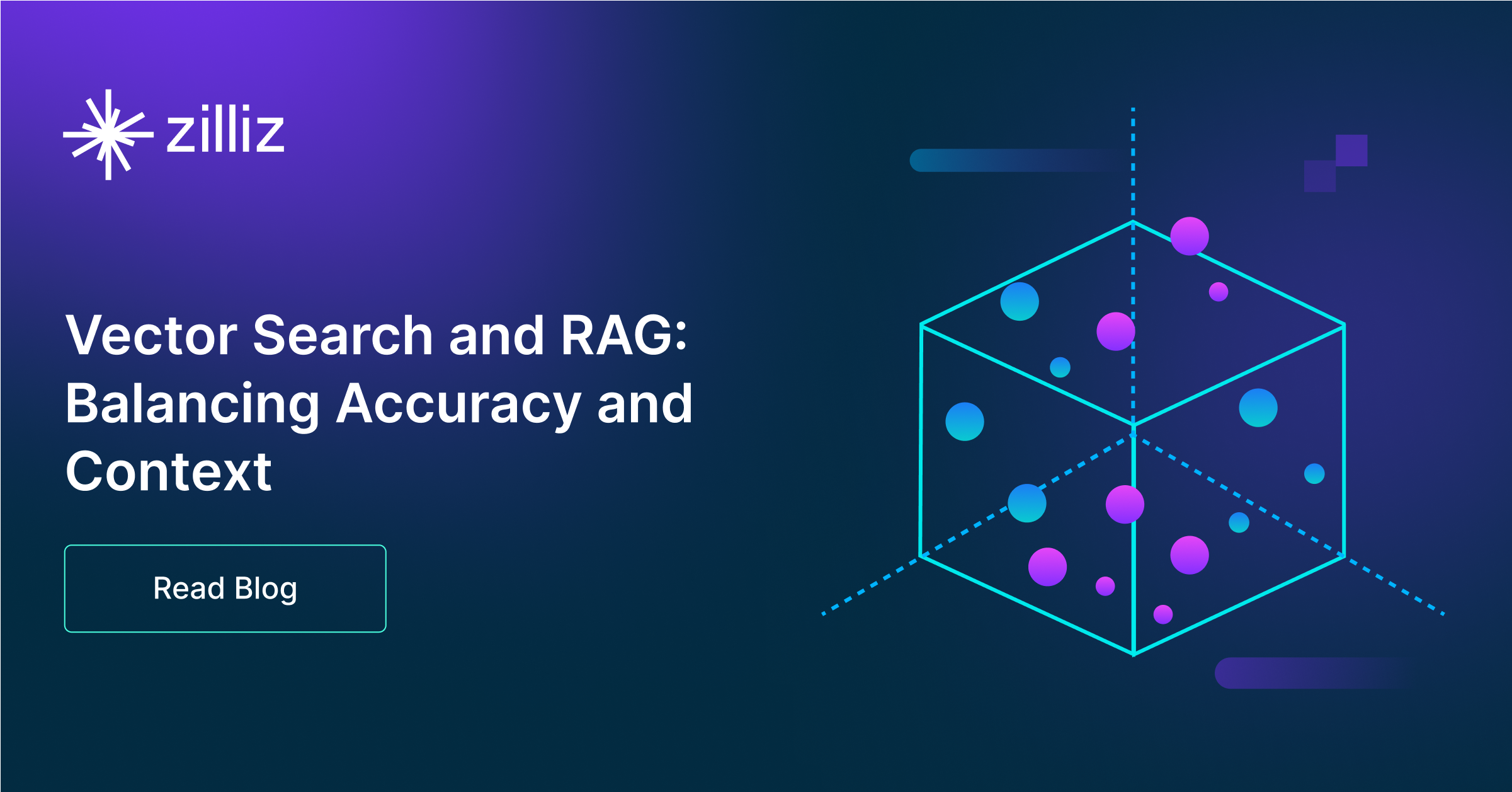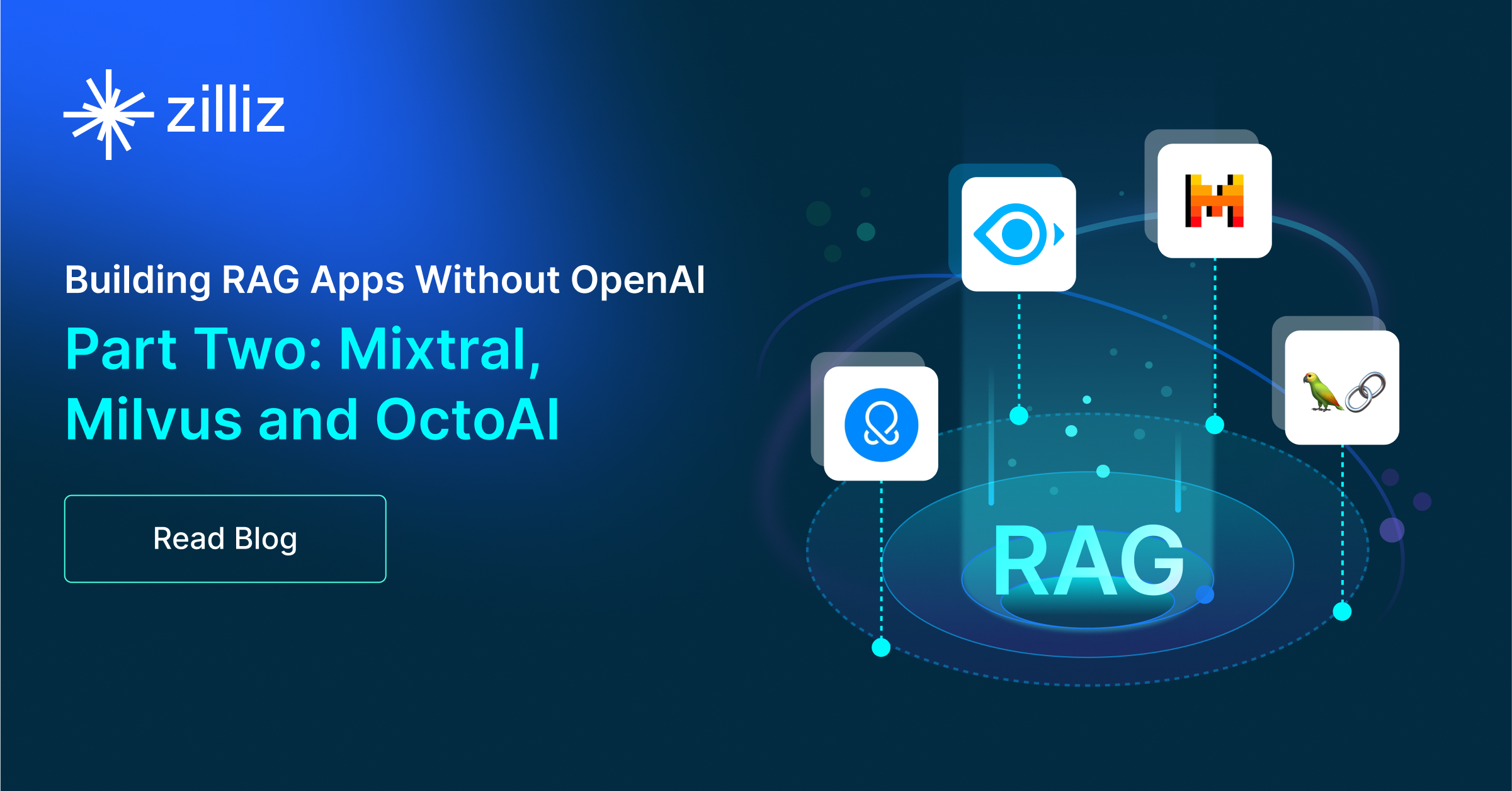Build RAG Chatbot with LangChain, pgvector, Cohere Command R+, and Google Vertex AI textembedding-gecko@003
Introduction to RAG
Retrieval-Augmented Generation (RAG) is a game-changer for GenAI applications, especially in conversational AI. It combines the power of pre-trained large language models (LLMs) like OpenAI’s GPT with external knowledge sources stored in vector databases such as Milvus and Zilliz Cloud, allowing for more accurate, contextually relevant, and up-to-date response generation. A RAG pipeline usually consists of four basic components: a vector database, an embedding model, an LLM, and a framework.
Key Components We'll Use for This RAG Chatbot
This tutorial shows you how to build a simple RAG chatbot in Python using the following components:
- LangChain: An open-source framework that helps you orchestrate the interaction between LLMs, vector stores, embedding models, etc, making it easier to integrate a RAG pipeline.
- Pgvector: an open-source extension for PostgreSQL that enables efficient storage and querying of high-dimensional vector data, essential for machine learning and AI applications. Designed to handle embeddings, it supports fast approximate nearest neighbor (ANN) searches using algorithms like HNSW and IVFFlat. Since it is just a vector search add-on to traditional search rather than a purpose-built vector database, it lacks scalability and availability and many other advanced features required by enterprise-level applications. Therefore, if you prefer a much more scalable solution or hate to manage your own infrastructure, we recommend using Zilliz Cloud, which is a fully managed vector database service built on the open-source Milvus and offers a free tier supporting up to 1 million vectors.)
- Cohere Command R+: This model specializes in rapid retrieval and dense text understanding, prioritizing performance in search and information extraction tasks. With enhanced contextual awareness, it delivers accurate results, making it ideal for applications in customer support, content recommendation, and enterprise search solutions that demand high efficiency and relevance in responses.
- Google Vertex AI textembedding-gecko@003: This model specializes in generating high-quality text embeddings for diverse applications, including semantic search and content recommendation. It leverages advanced techniques for contextual understanding, ensuring accurate representations of intricate text. Ideal for integration into systems needing scalable and efficient NLP solutions, enhancing user experience in real-time applications.
By the end of this tutorial, you’ll have a functional chatbot capable of answering questions based on a custom knowledge base.
Note: Since we may use proprietary models in our tutorials, make sure you have the required API key beforehand.
Step 1: Install and Set Up LangChain
%pip install --quiet --upgrade langchain-text-splitters langchain-community langgraph
Step 2: Install and Set Up Cohere Command R+
pip install -qU "langchain[cohere]"
import getpass
import os
if not os.environ.get("COHERE_API_KEY"):
os.environ["COHERE_API_KEY"] = getpass.getpass("Enter API key for Cohere: ")
from langchain.chat_models import init_chat_model
llm = init_chat_model("command-r-plus", model_provider="cohere")
Step 3: Install and Set Up Google Vertex AI textembedding-gecko@003
pip install -qU langchain-google-vertexai
from langchain_google_vertexai import VertexAIEmbeddings
embeddings = VertexAIEmbeddings(model="textembedding-gecko@003")
Step 4: Install and Set Up pgvector
pip install -qU langchain-postgres
from langchain_postgres import PGVector
vector_store = PGVector(
embeddings=embeddings,
collection_name="my_docs",
connection="postgresql+psycopg://...",
)
Step 5: Build a RAG Chatbot
Now that you’ve set up all components, let’s start to build a simple chatbot. We’ll use the Milvus introduction doc as a private knowledge base. You can replace it with your own dataset to customize your RAG chatbot.
import bs4
from langchain import hub
from langchain_community.document_loaders import WebBaseLoader
from langchain_core.documents import Document
from langchain_text_splitters import RecursiveCharacterTextSplitter
from langgraph.graph import START, StateGraph
from typing_extensions import List, TypedDict
# Load and chunk contents of the blog
loader = WebBaseLoader(
web_paths=("https://milvus.io/docs/overview.md",),
bs_kwargs=dict(
parse_only=bs4.SoupStrainer(
class_=("doc-style doc-post-content")
)
),
)
docs = loader.load()
text_splitter = RecursiveCharacterTextSplitter(chunk_size=1000, chunk_overlap=200)
all_splits = text_splitter.split_documents(docs)
# Index chunks
_ = vector_store.add_documents(documents=all_splits)
# Define prompt for question-answering
prompt = hub.pull("rlm/rag-prompt")
# Define state for application
class State(TypedDict):
question: str
context: List[Document]
answer: str
# Define application steps
def retrieve(state: State):
retrieved_docs = vector_store.similarity_search(state["question"])
return {"context": retrieved_docs}
def generate(state: State):
docs_content = "\n\n".join(doc.page_content for doc in state["context"])
messages = prompt.invoke({"question": state["question"], "context": docs_content})
response = llm.invoke(messages)
return {"answer": response.content}
# Compile application and test
graph_builder = StateGraph(State).add_sequence([retrieve, generate])
graph_builder.add_edge(START, "retrieve")
graph = graph_builder.compile()
Test the Chatbot
Yeah! You've built your own chatbot. Let's ask the chatbot a question.
response = graph.invoke({"question": "What data types does Milvus support?"})
print(response["answer"])
Example Output
Milvus supports various data types including sparse vectors, binary vectors, JSON, and arrays. Additionally, it handles common numerical and character types, making it versatile for different data modeling needs. This allows users to manage unstructured or multi-modal data efficiently.
Optimization Tips
As you build your RAG system, optimization is key to ensuring peak performance and efficiency. While setting up the components is an essential first step, fine-tuning each one will help you create a solution that works even better and scales seamlessly. In this section, we’ll share some practical tips for optimizing all these components, giving you the edge to build smarter, faster, and more responsive RAG applications.
LangChain optimization tips
To optimize LangChain, focus on minimizing redundant operations in your workflow by structuring your chains and agents efficiently. Use caching to avoid repeated computations, speeding up your system, and experiment with modular design to ensure that components like models or databases can be easily swapped out. This will provide both flexibility and efficiency, allowing you to quickly scale your system without unnecessary delays or complications.
pgvector optimization tips
To optimize pgvector in a Retrieval-Augmented Generation (RAG) setup, consider indexing your vectors using GiST or IVFFlat to significantly speed up search queries and improve retrieval performance. Make sure to leverage parallelization for query execution, allowing multiple queries to be processed simultaneously, especially for large datasets. Optimize memory usage by tuning the vector storage size and using compressed embeddings where possible. To further enhance query speed, implement pre-filtering techniques to narrow down search space before querying. Regularly rebuild indexes to ensure they are up to date with any new data. Fine-tune vectorization models to reduce dimensionality without sacrificing accuracy, thus improving both storage efficiency and retrieval times. Finally, manage resource allocation carefully, utilizing horizontal scaling for larger datasets and offloading intensive operations to dedicated processing units to maintain responsiveness during high-traffic periods.
Cohere Command R+ optimization tips
Cohere Command R+ is an advanced model optimized for retrieval-heavy workloads, making it essential to refine context selection and ranking mechanisms. Use Cohere’s reranking models to sort retrieved passages based on semantic relevance, ensuring only the most pertinent information is processed. Optimize token economy by segmenting documents into meaningful chunks and limiting unnecessary context, preventing prompt overloading. Adjust retrieval depth dynamically based on query complexity—broader searches for complex queries and narrower ones for straightforward prompts. Fine-tune temperature and sampling parameters based on use cases, with lower values ensuring more reliable, factual outputs. For high-throughput applications, implement asynchronous processing and parallel query execution to improve efficiency. Caching and pre-generating responses for frequently accessed topics can significantly reduce inference costs and improve response time. Regularly test and refine retrieval configurations based on user feedback and performance analytics to maintain high-quality outputs in RAG workflows.
Google Vertex AI textembedding-gecko@003 optimization tips
Google Vertex AI textembedding-gecko@003 is designed for advanced text understanding, making it ideal for high-accuracy RAG applications. Optimize embedding generation by removing noisy data and focusing on the most relevant content within documents. Use efficient vector search algorithms, such as FAISS with IVF or HNSW, to ensure fast and accurate document retrieval. Batch text embeddings for large volumes of data to speed up processing and minimize latency. Implement caching for high-frequency queries and periodically refresh embeddings to keep up with changes in the data landscape. Fine-tune the model on domain-specific tasks to improve relevance in specialized RAG applications. Consider deploying a multi-stage search strategy with semantic and keyword-based approaches for optimal accuracy and performance.
By implementing these tips across your components, you'll be able to enhance the performance and functionality of your RAG system, ensuring it’s optimized for both speed and accuracy. Keep testing, iterating, and refining your setup to stay ahead in the ever-evolving world of AI development.
RAG Cost Calculator: A Free Tool to Calculate Your Cost in Seconds
Estimating the cost of a Retrieval-Augmented Generation (RAG) pipeline involves analyzing expenses across vector storage, compute resources, and API usage. Key cost drivers include vector database queries, embedding generation, and LLM inference.
RAG Cost Calculator is a free tool that quickly estimates the cost of building a RAG pipeline, including chunking, embedding, vector storage/search, and LLM generation. It also helps you identify cost-saving opportunities and achieve up to 10x cost reduction on vector databases with the serverless option.
 Calculate your RAG cost
Calculate your RAG cost
What Have You Learned?
By diving into this tutorial, you’ve unlocked the magic of building a fully functional RAG system from the ground up! You learned how LangChain acts as the glue, seamlessly orchestrating the flow between your data pipeline, retrieval mechanisms, and language model. With pgvector as your vector database, you now have a powerful tool for storing and querying embeddings at scale, ensuring lightning-fast similarity searches that make your RAG system responsive and efficient. Cohere’s Command R+ stepped in as the LLM powerhouse, generating human-like, context-aware responses by leveraging the retrieved knowledge, while Google’s textembedding-gecko@003 model transformed raw text into rich, semantic embeddings—giving your system the ability to “understand” and prioritize information like never before. Together, these components form a dynamic pipeline that bridges the gap between static data and intelligent, real-time interactions.
But it doesn’t stop there! You also picked up pro tips for optimizing your RAG pipeline, like tweaking chunk sizes for better retrieval or balancing cost and performance with hybrid search strategies. The free RAG cost calculator you explored is a game-changer, helping you estimate expenses and make informed decisions as you scale. Now that you’ve seen how these pieces fit together—and how even small adjustments can lead to big improvements—you’re ready to take the reins. Imagine the applications you could build: smarter chatbots, hyper-personalized recommendation engines, or research tools that feel like magic. The tools are in your hands, the foundation is set, and the possibilities are limitless. So go ahead—experiment, iterate, and create something groundbreaking. Your next RAG-powered innovation is just a few lines of code away!
Further Resources
🌟 In addition to this RAG tutorial, unleash your full potential with these incredible resources to level up your RAG skills.
- How to Build a Multimodal RAG | Documentation
- How to Enhance the Performance of Your RAG Pipeline
- Graph RAG with Milvus | Documentation
- How to Evaluate RAG Applications - Zilliz Learn
- Generative AI Resource Hub | Zilliz
We'd Love to Hear What You Think!
We’d love to hear your thoughts! 🌟 Leave your questions or comments below or join our vibrant Milvus Discord community to share your experiences, ask questions, or connect with thousands of AI enthusiasts. Your journey matters to us!
If you like this tutorial, show your support by giving our Milvus GitHub repo a star ⭐—it means the world to us and inspires us to keep creating! 💖
- Introduction to RAG
- Key Components We'll Use for This RAG Chatbot
- Step 1: Install and Set Up LangChain
- Step 2: Install and Set Up Cohere Command R+
- Step 3: Install and Set Up Google Vertex AI textembedding-gecko@003
- Step 4: Install and Set Up pgvector
- Step 5: Build a RAG Chatbot
- Optimization Tips
- RAG Cost Calculator: A Free Tool to Calculate Your Cost in Seconds
- What Have You Learned?
- Further Resources
- We'd Love to Hear What You Think!
Content
Vector Database at Scale
Zilliz Cloud is a fully-managed vector database built for scale, perfect for your RAG apps.
Try Zilliz Cloud for Free


